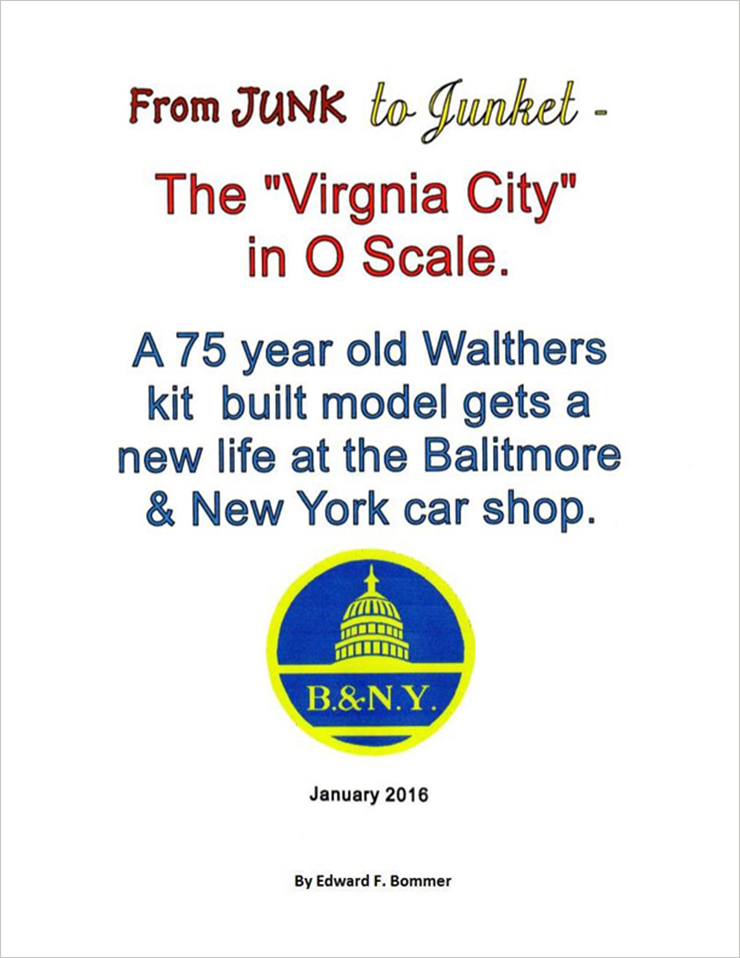
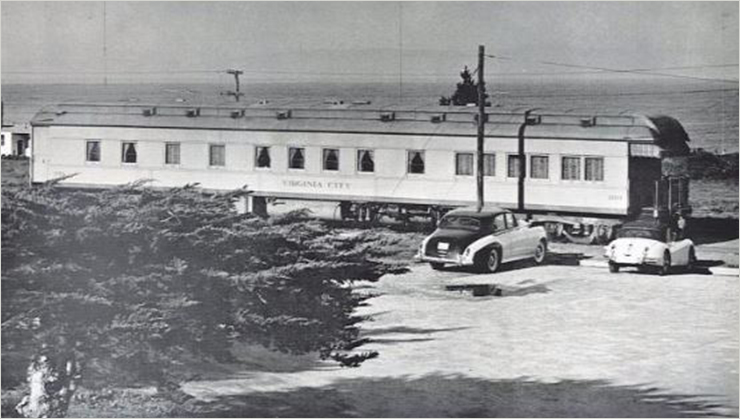 This photo of Lucius Beebe’s and Charles Clegg’s private car “Virginia City” at Monterey CA in 1956 sparked an idea to recreate this scene in O scale. Over several years, one piece and then another was found to help fulfill that idea. The observation car was not the hardest thing to locate. It was the two automobiles! They are a 1955 Rolls Royce Silver Cloud saloon (sedan to us Yanks) with its English Coaching Yellow and Black paint job modified on the rear wings (fenders).
This photo of Lucius Beebe’s and Charles Clegg’s private car “Virginia City” at Monterey CA in 1956 sparked an idea to recreate this scene in O scale. Over several years, one piece and then another was found to help fulfill that idea. The observation car was not the hardest thing to locate. It was the two automobiles! They are a 1955 Rolls Royce Silver Cloud saloon (sedan to us Yanks) with its English Coaching Yellow and Black paint job modified on the rear wings (fenders).

This one, a Verem from 1965 with a sprung suspension, was found on eBay in 2005 and came from the Netherlands. That pink paint job had to go, though!
 Looks so much better after a visit to the model body shop!
Looks so much better after a visit to the model body shop!
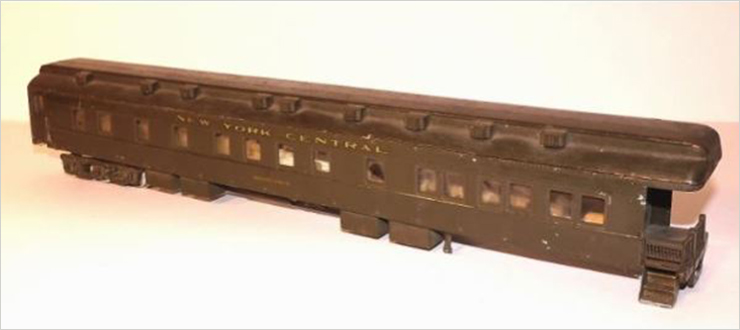 Next, this elderly Walthers observation in sad shape was found at the March 2010 Midwest O Scale Meet for $10. It was a model for the same Pullman Plan (3959a) that became the “Virginia City,” a 3 compartment / 2 drawing room / lounge / observation built in 1928.
Next, this elderly Walthers observation in sad shape was found at the March 2010 Midwest O Scale Meet for $10. It was a model for the same Pullman Plan (3959a) that became the “Virginia City,” a 3 compartment / 2 drawing room / lounge / observation built in 1928.
 It had pre-WWII wooden ventilators and one original truck. The rear platform, with its built-up brass railing was missing two sections. Two car steps made of folded sheet brass were missing as well. There were a few interior walls made from cigar box wood. The gold Walthers decals for New York Central had fine, black outlining.
It had pre-WWII wooden ventilators and one original truck. The rear platform, with its built-up brass railing was missing two sections. Two car steps made of folded sheet brass were missing as well. There were a few interior walls made from cigar box wood. The gold Walthers decals for New York Central had fine, black outlining.
So it sat in a box for a few more years until a 1954 Jaguar XK-140 with its top up was found in 2012.
 A 2012 Vitesse release from London, England, it was only available in black.
A 2012 Vitesse release from London, England, it was only available in black.
 It would take a complete dismantling to turn this into an Old English White roadster with a cherry red leather interior, per 1954 Jaguar specs.
It would take a complete dismantling to turn this into an Old English White roadster with a cherry red leather interior, per 1954 Jaguar specs.
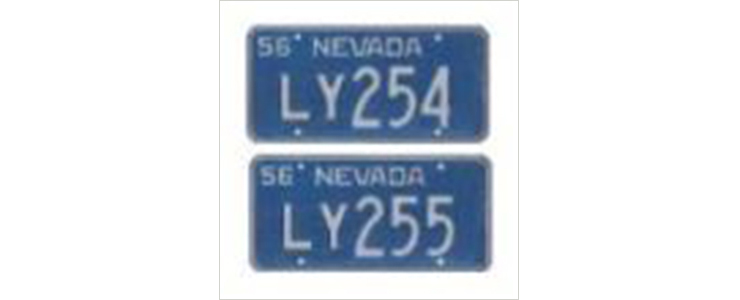 1956 Nevada tags for Lyons County were put on the two autos, since Beebe and Clegg lived in Carson City NV at the time.
1956 Nevada tags for Lyons County were put on the two autos, since Beebe and Clegg lived in Carson City NV at the time.
 With all that in place and the Walthers observation hiding in its storage box, what about the setting? I thought of making a diorama for it that could sit on the fireplace mantle, since I no longer have a layout.
With all that in place and the Walthers observation hiding in its storage box, what about the setting? I thought of making a diorama for it that could sit on the fireplace mantle, since I no longer have a layout.
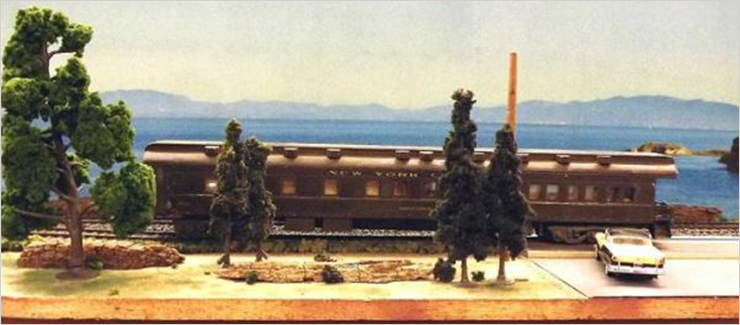 The back drop is from a Union Pacific magazine ad, flipped to put the background rocks in the bay on the right side. Some trees from the old layout were used again. The ‘rocks’ on the foreground are pieces of tree bark. The ancient Walthers car sits on the siding, awaiting transformation into the elegant “Virginia City.” More scenery and finish work is still needed on the diorama.
The back drop is from a Union Pacific magazine ad, flipped to put the background rocks in the bay on the right side. Some trees from the old layout were used again. The ‘rocks’ on the foreground are pieces of tree bark. The ancient Walthers car sits on the siding, awaiting transformation into the elegant “Virginia City.” More scenery and finish work is still needed on the diorama.
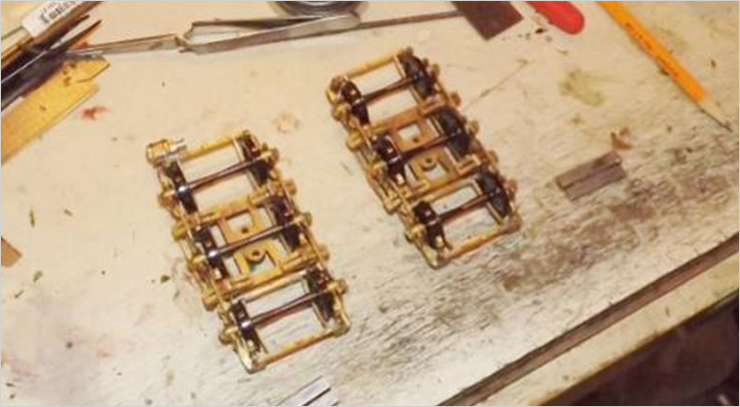 But the car needed trucks! A friend and fellow O scale modeler in New Hampshire sent me a kit for a pair of brass Precision Scale Pullman type 2410 trucks, which are accurate for this car. Here I am adding swing hanger spring planks, which PSC did not include. A truck mounted generator was added as the “Virginia City” was so equipped on its rear truck.
But the car needed trucks! A friend and fellow O scale modeler in New Hampshire sent me a kit for a pair of brass Precision Scale Pullman type 2410 trucks, which are accurate for this car. Here I am adding swing hanger spring planks, which PSC did not include. A truck mounted generator was added as the “Virginia City” was so equipped on its rear truck.
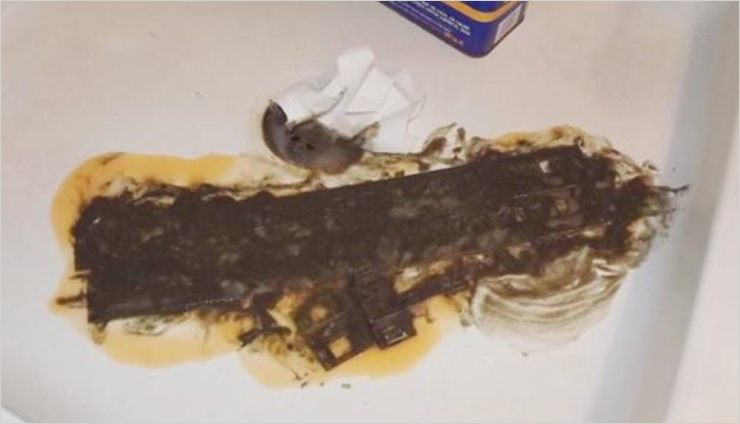 Of course, the Walthers car had to be ’re-kitted’ and all the old paint stripped off. Messy but necessary.
Of course, the Walthers car had to be ’re-kitted’ and all the old paint stripped off. Messy but necessary.
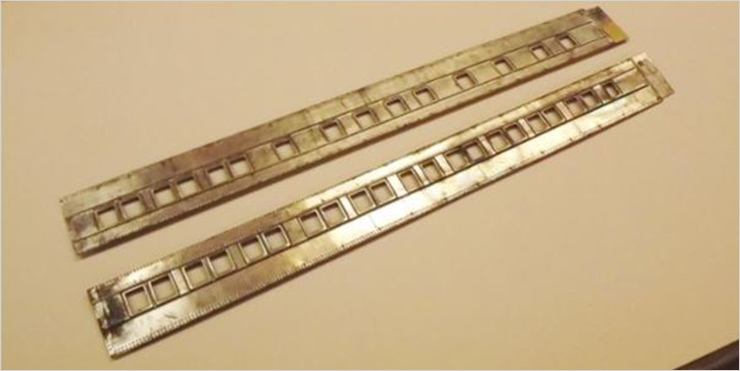 The sides now clean, show the original builders fingerprints forever etched into the tin plating. Some 36 tiny escutcheon pins held each side to the car body, typical of 1940s assembly methods. One vestibule door was blanked off on the left side, per the prototype.
The sides now clean, show the original builders fingerprints forever etched into the tin plating. Some 36 tiny escutcheon pins held each side to the car body, typical of 1940s assembly methods. One vestibule door was blanked off on the left side, per the prototype.
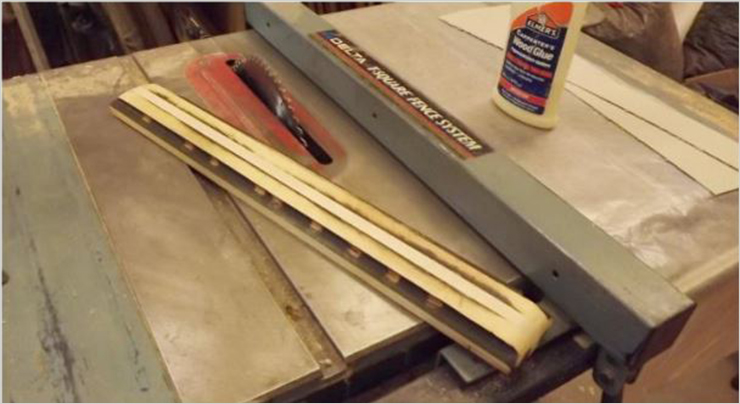 The original wood roof had a narrow clerestory. The prototype was 7’ 9” wide and nobody made one like it for O scale. So the old wood roof took a trip through the table saw, to slice it in half. A ½”x ½” strip of wood was glued between the halves to widen the clerestory.
The original wood roof had a narrow clerestory. The prototype was 7’ 9” wide and nobody made one like it for O scale. So the old wood roof took a trip through the table saw, to slice it in half. A ½”x ½” strip of wood was glued between the halves to widen the clerestory.
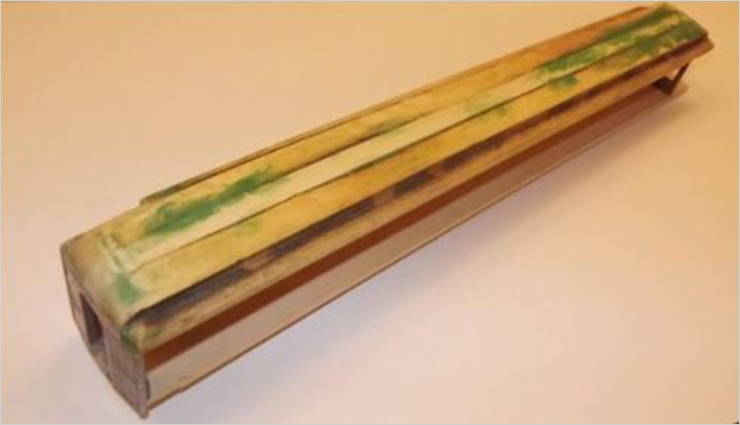 Now the roof bottom was too wide, so two more trips through the table saw reduced it to the correct width. A few more passes were done to undercut the edges per Walthers, where the car sides fit. Then, the lower portions of the roof were rounded off to suit with a Shure-Form, files and sandpaper.
Now the roof bottom was too wide, so two more trips through the table saw reduced it to the correct width. A few more passes were done to undercut the edges per Walthers, where the car sides fit. Then, the lower portions of the roof were rounded off to suit with a Shure-Form, files and sandpaper.
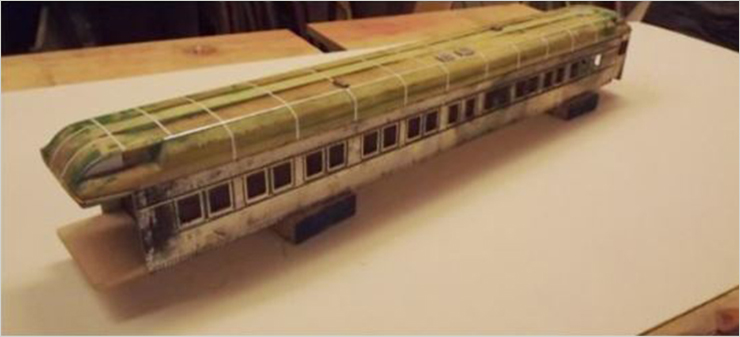 Next came new ventilators, batten strips and other roof details following prototype photos. The high shouldered AC duct is something rarely modeled correctly in O scale, even on high priced, imported brass models.
Next came new ventilators, batten strips and other roof details following prototype photos. The high shouldered AC duct is something rarely modeled correctly in O scale, even on high priced, imported brass models.
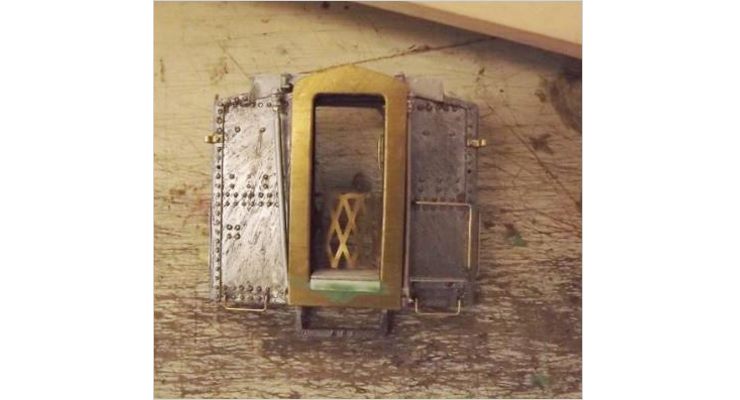 Widening the clerestory also meant modifying the car’s vestibule end to suit. The original diaphragm and brass plate that were inside the old car were used again. New grab irons hand rails, marker light brackets and other details have been added.
Widening the clerestory also meant modifying the car’s vestibule end to suit. The original diaphragm and brass plate that were inside the old car were used again. New grab irons hand rails, marker light brackets and other details have been added.
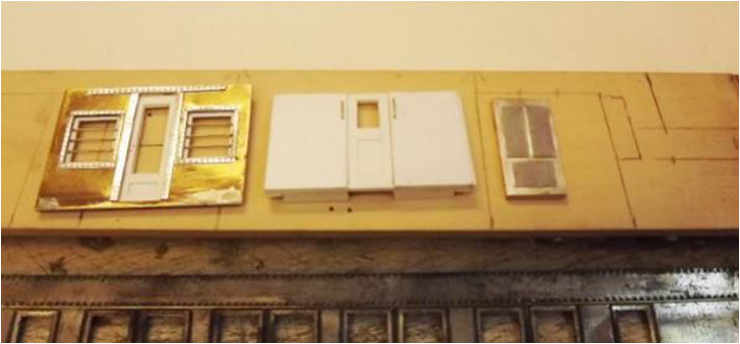 The rear platform wall made of .050” thick brass, was given a new styrene door, rivet details and safety bars over the windows. An inside vestibule wall and door was made in styrene, along with an aluminum faced panel for a storage refrigerator in the vestibule.
The rear platform wall made of .050” thick brass, was given a new styrene door, rivet details and safety bars over the windows. An inside vestibule wall and door was made in styrene, along with an aluminum faced panel for a storage refrigerator in the vestibule.
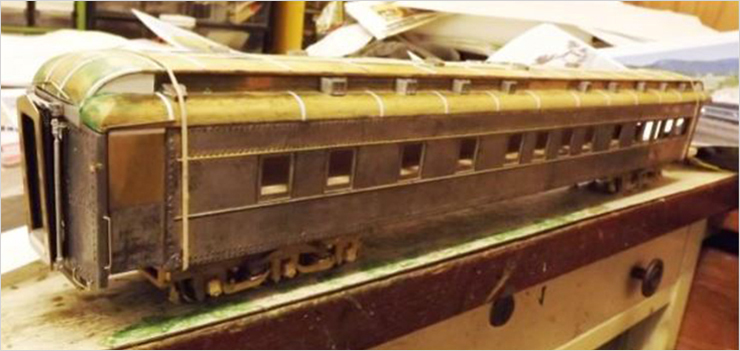 A test fit of the basic parts. Keil Line car step castings replaced the folded sheet brass originals.
A test fit of the basic parts. Keil Line car step castings replaced the folded sheet brass originals.
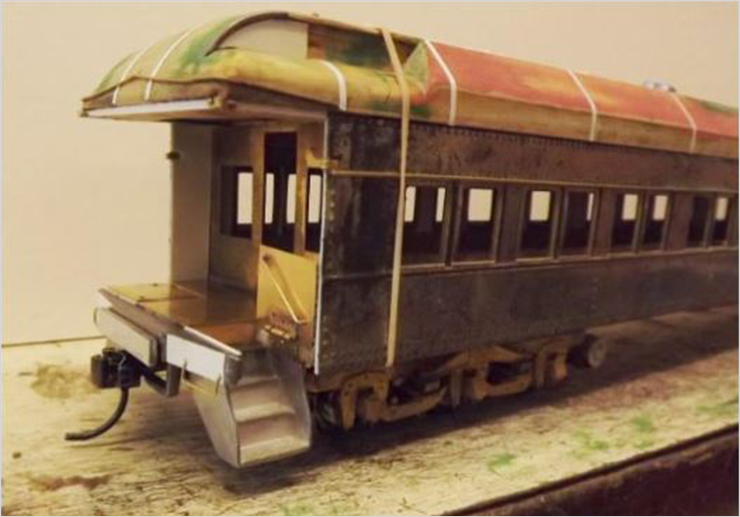 Now to create working trap doors and railing gates for the platform end. The brass hinges for the trap doors are doll house items. A bit bulky, but more suitable for these working parts.
Now to create working trap doors and railing gates for the platform end. The brass hinges for the trap doors are doll house items. A bit bulky, but more suitable for these working parts.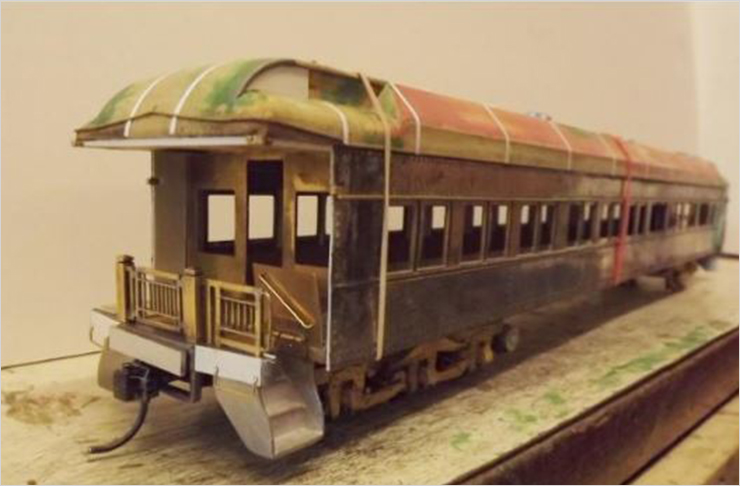
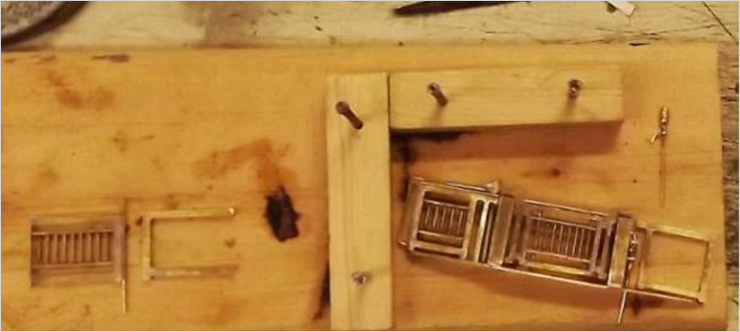 Missing pieces for the end railing and a side gate were scratch made in brass, using the original railing as a reference and guide. The handbrake, backing whistle and piping for the conductor’s brake valve were also made. The original side gate to the left has been fitted with its hinge rod.
Missing pieces for the end railing and a side gate were scratch made in brass, using the original railing as a reference and guide. The handbrake, backing whistle and piping for the conductor’s brake valve were also made. The original side gate to the left has been fitted with its hinge rod.
 The restored platform railing is test fitted. The side gates can swing inward and the trap doors over the car steps lift up on each side, as seen below:
The restored platform railing is test fitted. The side gates can swing inward and the trap doors over the car steps lift up on each side, as seen below: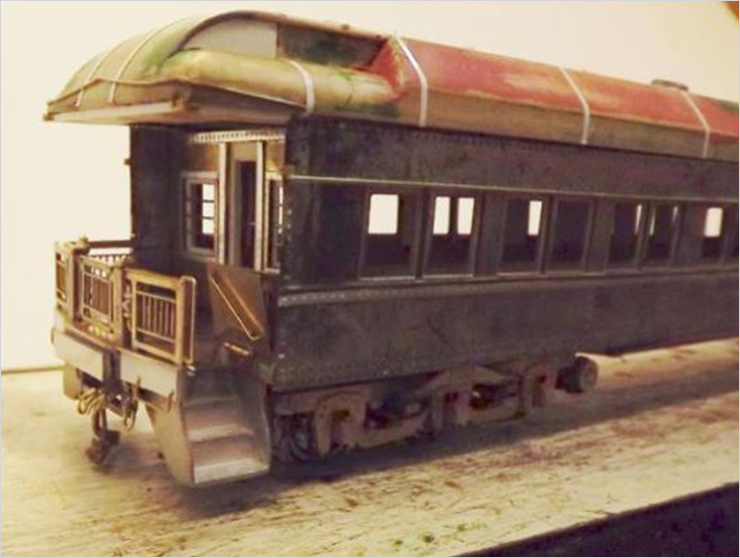
With that taken care of, the underbody details are next. Basically they are made from pieces of wood, fitted to suit and detailed with thin sheet aluminum or styrene coverings. A Pullman plan was used as guide. But beware! It shows the underbody by looking down, through the floor. 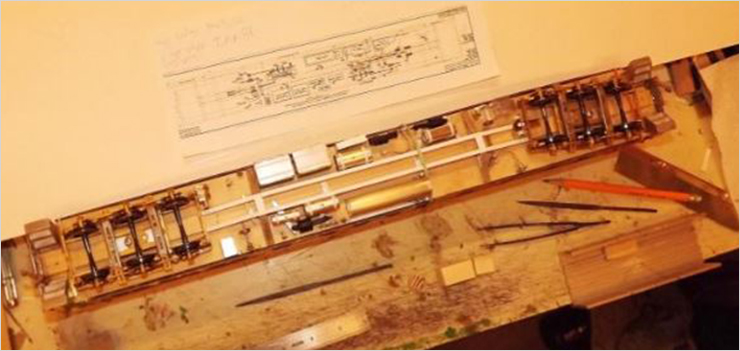
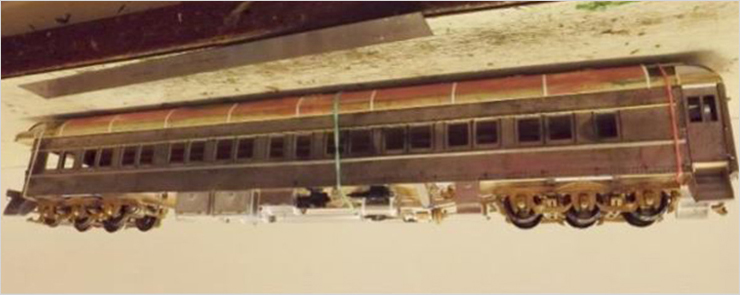 To check it against photos before gluing anything in place, the car was set on its roof. Here, I flipped one of the photos I took to show how the under body details line up on the right side. There were a few differences between the prototype “Virginia City” and the Pullman drawing.
To check it against photos before gluing anything in place, the car was set on its roof. Here, I flipped one of the photos I took to show how the under body details line up on the right side. There were a few differences between the prototype “Virginia City” and the Pullman drawing.
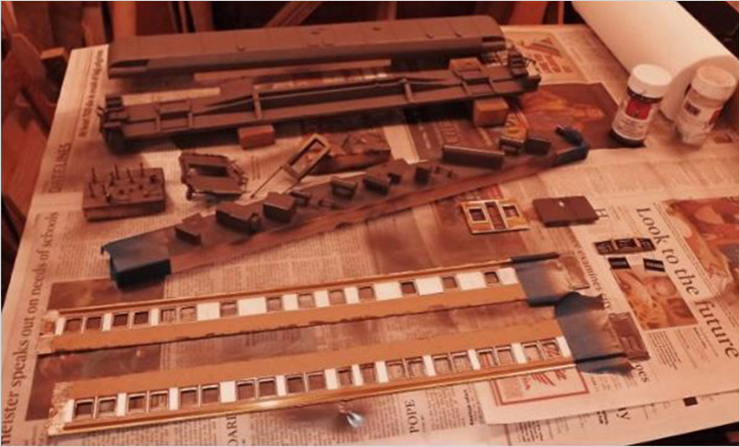 Then comes the paint. Scale Coat UP Harbor Mist Gray was first, for the under body and its parts, which will be permanently mounted after the paint dries, as well as the inside vestibule bulk head and doors as well as the rear platform door and window sash exteriors.
Then comes the paint. Scale Coat UP Harbor Mist Gray was first, for the under body and its parts, which will be permanently mounted after the paint dries, as well as the inside vestibule bulk head and doors as well as the rear platform door and window sash exteriors.
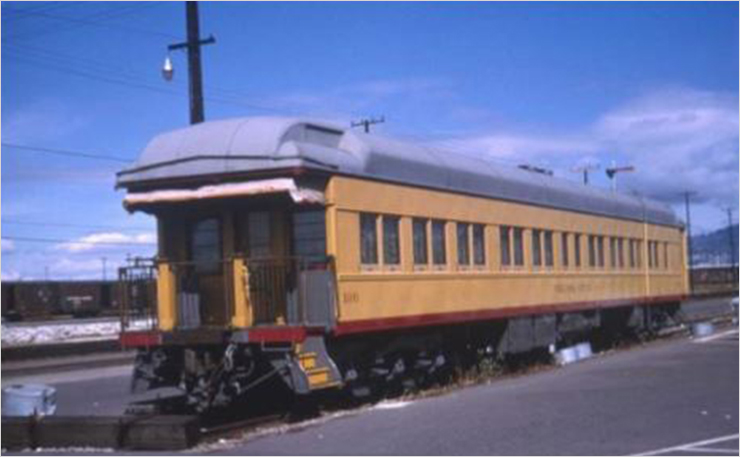 Of course a prototype color photo helps. They are quite rare. Here “Virginia City” is in the Southern Pacific yard at Sparks NV in the 1960s. No longer in use after Beebe died, it remained in storage.
Of course a prototype color photo helps. They are quite rare. Here “Virginia City” is in the Southern Pacific yard at Sparks NV in the 1960s. No longer in use after Beebe died, it remained in storage.
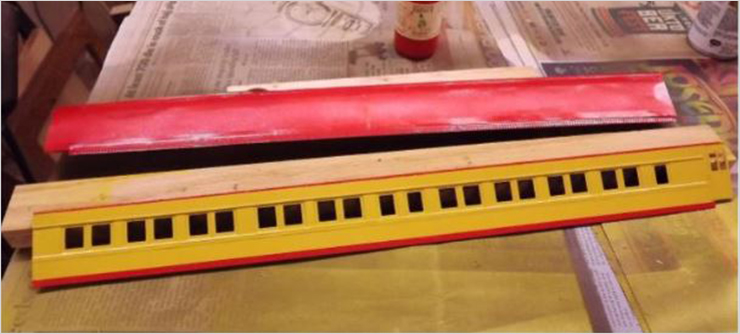 UP Scale Coat UP Armour Yellow was applied to both sides first. Several days later, the sides were masked and Scale Coat Rock Island Red was used for the upper and lower striping. Easy to do at this point and better than trying to stripe them with decals later.
UP Scale Coat UP Armour Yellow was applied to both sides first. Several days later, the sides were masked and Scale Coat Rock Island Red was used for the upper and lower striping. Easy to do at this point and better than trying to stripe them with decals later.
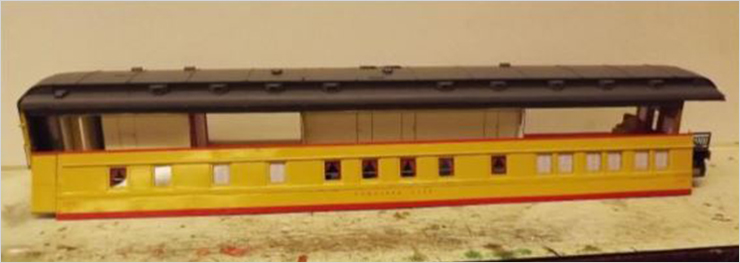 The car name and numbers were done with Micro Scale red Railroad Roman alphabet decals. Unfortunately the print was thin in the middle of the letters, making them pale. Trying to re-decal over them to increase the contrast did not work well. Inside the car, walls and dividers made of sheet styrene are in place, as are carpets and a few interior details that can be seen through windows.
The car name and numbers were done with Micro Scale red Railroad Roman alphabet decals. Unfortunately the print was thin in the middle of the letters, making them pale. Trying to re-decal over them to increase the contrast did not work well. Inside the car, walls and dividers made of sheet styrene are in place, as are carpets and a few interior details that can be seen through windows.
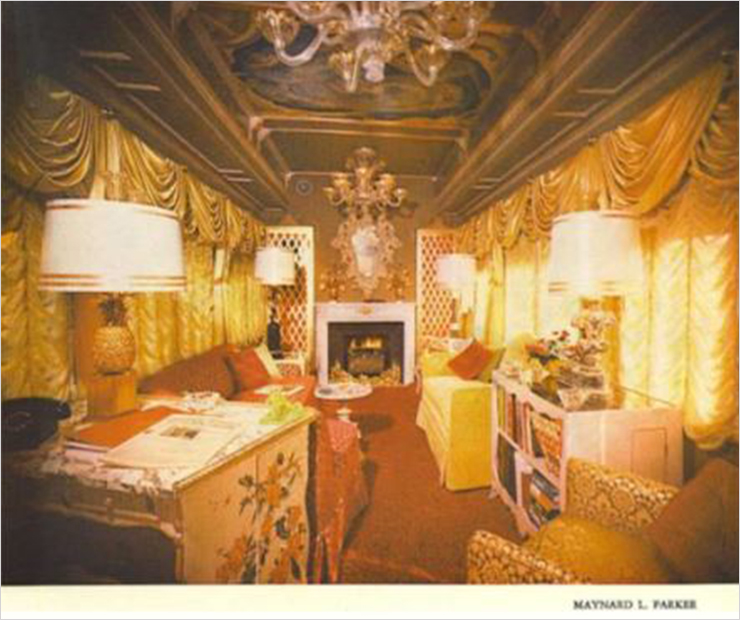 “Virginia City” nearly always had all the curtains and binds drawn shut. So the elaborate “Late Venetian Renaissance” interior décor does not need to be modeled! Here is an example showing the prototype’s lounge as seen from the rear platform doorway.
“Virginia City” nearly always had all the curtains and binds drawn shut. So the elaborate “Late Venetian Renaissance” interior décor does not need to be modeled! Here is an example showing the prototype’s lounge as seen from the rear platform doorway.
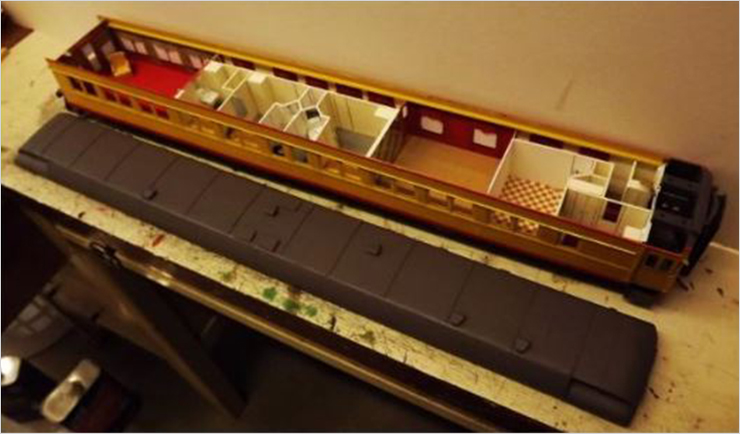 The kitchen needs more detail as its windows do not have the shades down. A range, refrigerator, sinks and counter space will be put in, along with some cabinets.
The kitchen needs more detail as its windows do not have the shades down. A range, refrigerator, sinks and counter space will be put in, along with some cabinets.
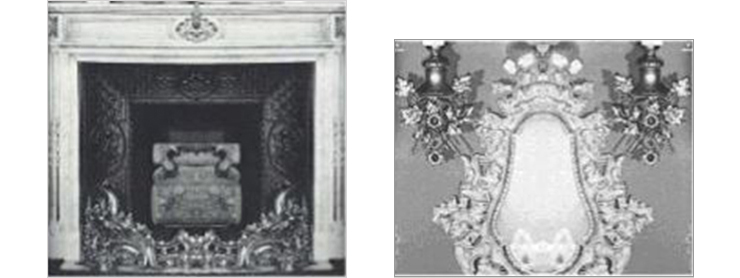 Because the inside wall of the lounge can be seen through the door, the fireplace and mirror above it are done with printed photos that were later shaded with colored pencils. To make the mirror reflective, it was cut out. A bit of an AAA chrome bumper sticker was put on the wall with cut-out frame over it.
Because the inside wall of the lounge can be seen through the door, the fireplace and mirror above it are done with printed photos that were later shaded with colored pencils. To make the mirror reflective, it was cut out. A bit of an AAA chrome bumper sticker was put on the wall with cut-out frame over it.
The Austrian style curtains (below) were computer printed to the window sizes needed on thinnest paper the printer could swallow, then cut and fitted in place behind the glazing. 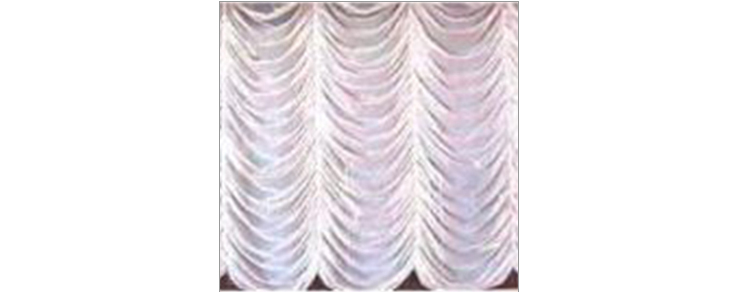 Red and gold drapes were cut from fabric treated with ACC to keep them from fraying and glued in place over the curtains.
Red and gold drapes were cut from fabric treated with ACC to keep them from fraying and glued in place over the curtains.
 All assembled for another check on the under body and truck swing. Long shank 700 series Kadee couplers were installed.
All assembled for another check on the under body and truck swing. Long shank 700 series Kadee couplers were installed.
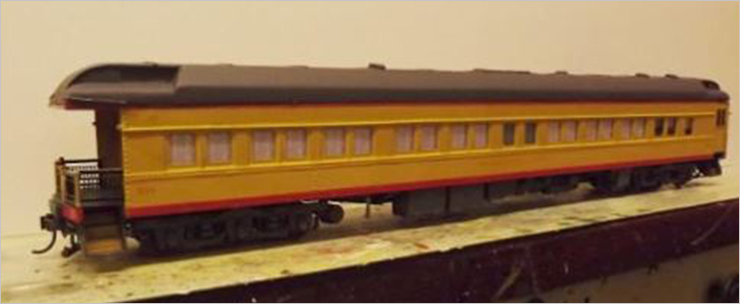
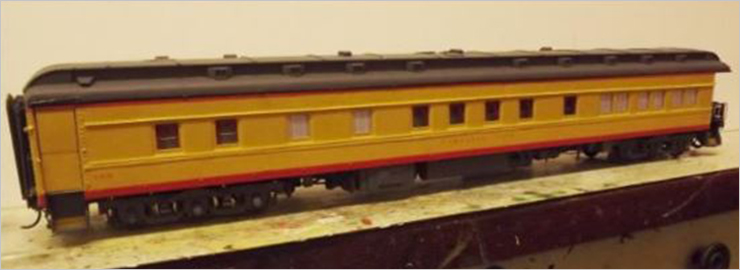
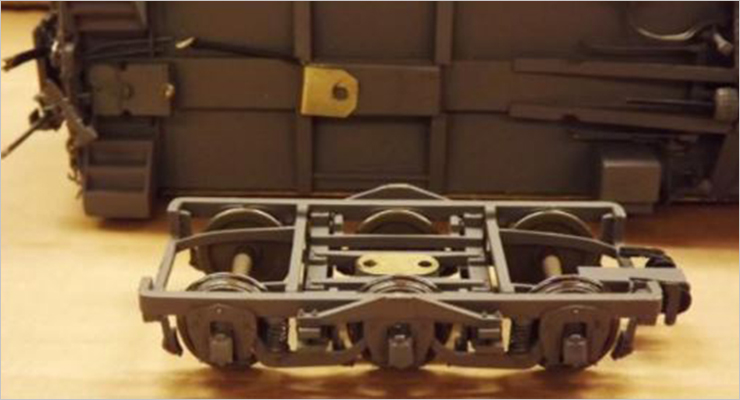 The car will be equipped with interior lighting. Here is a centerplate contact between the truck and bolster, which is done at each end. There is a conductor to the roof and its contact at the vestibule end. A similar arrangement is done with brass platform end wall serving as the conductor to the roof.
The car will be equipped with interior lighting. Here is a centerplate contact between the truck and bolster, which is done at each end. There is a conductor to the roof and its contact at the vestibule end. A similar arrangement is done with brass platform end wall serving as the conductor to the roof.
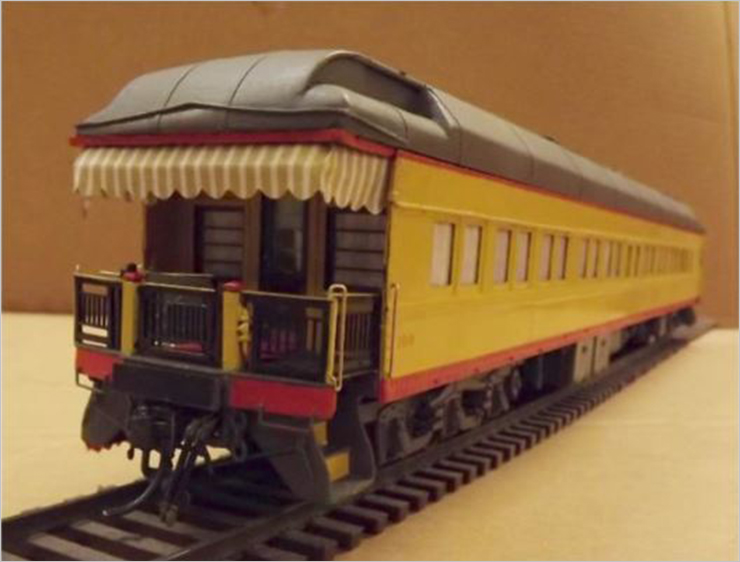 Brass rod and some gold and white striped fabric make up the rear platform’s awning. The roof snugly fits onto the body and is removable.
Brass rod and some gold and white striped fabric make up the rear platform’s awning. The roof snugly fits onto the body and is removable.
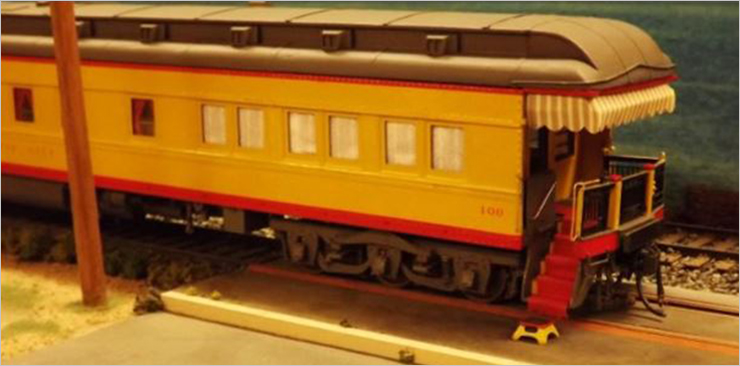 So welcome aboard the “Virginia City,” in its Monterey Bay diorama setting!
So welcome aboard the “Virginia City,” in its Monterey Bay diorama setting!
This article by Edward F.Bommer,
January 2016.





























 Because the inside wall of the lounge can be seen through the door, the fireplace and mirror above it are done with printed photos that were later shaded with colored pencils. To make the mirror reflective, it was cut out. A bit of an AAA chrome bumper sticker was put on the wall with cut-out frame over it.
Because the inside wall of the lounge can be seen through the door, the fireplace and mirror above it are done with printed photos that were later shaded with colored pencils. To make the mirror reflective, it was cut out. A bit of an AAA chrome bumper sticker was put on the wall with cut-out frame over it.










